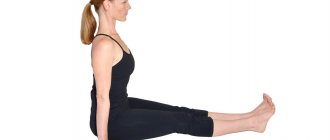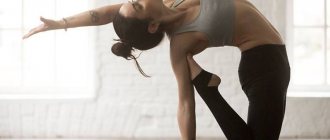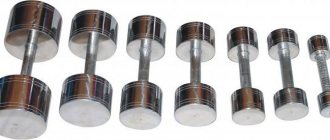Expert opinion
VALERIYA VOLKHINA, elite trainer at the Encore Fitness Moscow City club “The main rule in the fight for a thin waist is adjusting your diet.
First of all, we must balance the amount of proteins, fats and carbohydrates in the diet and create a calorie deficit. As a rule, with an active lifestyle, the calorie deficit should be small so that losing weight is not too stressful and the body does not start burning its own muscles. If you follow this rule, then gradually the body will begin to burn its own fat reserves.” In sports, I would recommend focusing on strength training and not getting carried away with cardio. Another myth is that the more cardio you do, the more fat you burn. In fact, cardio exercises primarily strengthen our cardiovascular system and make us more resilient. When a person gets too carried away on a treadmill or exercise bike, the opposite effect can occur. At first you will actually lose weight due to a calorie deficit, but at some point the body will begin to save even more, including in certain areas, usually the waist.
Unfortunately, there are no exercises that allow us to burn fat in any specific part of the body. Remember - there is no local fat burning. When a person begins to lose weight, fat gradually disappears from everywhere.
Therefore, I recommend adding strength training to proper nutrition, which will create the correct hormonal levels in the body and the muscle frame. Please don't confuse muscles with size. Muscle is a quality of your body. The more muscle mass in the body, the faster the basal metabolism, that is, the calories that a person spends at rest without any activity.
Your training should be deliberate, with an individual approach. You need to look at body features, proportions and focus on working with certain muscles. For example, if your waist is naturally wide, then you can visually reduce it by working the muscles of the back and shoulder girdle, plus enlarging the buttocks and hips - so the waist will appear narrower.
The next feature that can affect your training and work on a small waist is diastasis. Here, a relevant exercise would be a vacuum on the transverse abdominal muscle, Pilates and strengthening the oblique abdominal muscles. There is a misconception that working the obliques will only make your waist appear larger, but this is not true. The oblique muscles of the abdomen can be strengthened even for pregnant women so that the waist is supported by them from the side and the anterior white line of the abdomen does not diverge (this happens with diastasis).
Now let's talk about strength exercises for the abdominal muscles. Many are afraid of them because of the myth that, again, this can only increase the waist. Such exercises strengthen the abs, but if done in moderation with light weights, they will only be beneficial. The only thing we remove from strength training for the abdominal muscles is exercises with heavy weights and lateral bending of the body to the side with weights.
Exercise No. 1: Diagonal crunches on bare feet
All abdominal muscles are involved here with an emphasis on the obliques. Thanks to working on the hemisphere, we get a better stretch of the abdominal muscles, which helps us work these muscles more effectively without additional weights, without increasing the size of the waist. The most important thing is that at the point where we stretch the muscles as much as possible, do not relax the abs so that the load does not transfer to the back. We lift only the upper back (shoulder blades and shoulders), slightly directing the shoulder and arm with the dumbbell diagonally towards the opposite leg. Inhale while moving, when we lengthen the abdominal muscles, exhale during the effort, that is, when lifting the shoulder blades and shoulders. As you exhale, add in the abdomen.
All abdominal muscles are involved here with an emphasis on the obliques. Thanks to working on the hemisphere, we get a better stretch of the abdominal muscles, which helps us work these muscles more effectively without additional weights, without increasing the size of the waist. The most important thing is that at the point where we stretch the muscles as much as possible, do not relax the abs so that the load does not transfer to the back. We lift only the upper back (shoulder blades and shoulders), slightly directing the shoulder and arm with the dumbbell diagonally towards the opposite leg. Inhale while moving, when we lengthen the abdominal muscles, exhale during the effort, that is, when lifting the shoulder blades and shoulders. As you exhale, add in the abdomen.
Top 14 exercises for the sides and waist
This complex is suitable for everyone, regardless of the level of physical development, and will prepare the muscles for further stress.
Plank
The plank is a static and quite complex exercise that involves almost all major muscle groups. The duration of the plank should be at least 15 seconds. with a gradual increase to 2 minutes. In this case, the rest period between repetitions is 30 seconds. In total you need to do this exercise at least 3-4 times.
It is necessary to begin its implementation with the simplest variety, gradually increasing complexity.
In this regard, the following are highlighted:
- kneeling plank;
- plank with straight arms (basic);
- elbow bar.
The starting position for the basic version of the plank is lying on your stomach. Next, you need to place your hands shoulder-width apart and rise up, taking a lying position. The back and neck should be on the same line, the gaze directed forward. Under no circumstances should the pelvis sag, as this can cause unwanted tension in the lumbar region, and subsequently pain.
The stomach should be pulled in and tense. At the same time, you cannot hold your breath. The kneeling plank is simpler and differs from the basic one in the position of the legs. In the classic plank, the legs are straightened, and in this variation the starting position is on the knees. In this case, there is less load on the gluteal muscles and abs.
The elbow plank is the most difficult, but the most effective. Your elbows should be bent at a 90-degree angle and your body should be one continuous straight line. The plank exercise will not get rid of fat deposits on the waist, but it will form a beautiful muscle corset.
Turns with dumbbells
Dumbbell twists can be performed either standing or sitting. This is an effective strength exercise in which most of the load falls on the abdominal muscles. Regardless of the variety, it is recommended to perform 10-12 repetitions of this exercise in at least 2 approaches during the training process.
You need to take a standing position, bend your legs slightly, take a dumbbell in one hand, and place the other hand on top. As you inhale, you need to smoothly turn your body all the way, without moving your pelvis. Then, as you exhale, you need to return to the starting position and perform the same movement in the other direction, gradually increasing the pace.

The figure shows an example of a set of exercises to eliminate the sides and shape the waist.
When performing seated dumbbell turns, your legs should be crossed at the ankles, slightly bent at the knees, and suspended. The arms are also slightly bent. Next, you need to make a smooth turn with your body, maintaining balance, and touch the dumbbell to the floor on one side, return to the starting position and repeat again, but in the opposite direction.
Exercise with fitball
Exercises for the sides and waist using a fitball not only allow you to get rid of fat in the most problematic areas, but also develop coordination, flexibility, straighten your posture, and strengthen ligaments. When working with a fitball, do not forget to keep your abdominal muscles tense, then the training will be most effective.
In order to make your waist more refined, you can use the following load options with the ball:
- bending to the sides with the ball;
- lower abs exercise;
- reverse crunch.
When bending to the side, you need to kneel, place the fitball on the side and put your hand on it. The opposite leg must be put forward, lean towards the fitball, and then in the opposite direction. The hips should remain motionless. 15 tilts for each side will be enough.
The most difficult to work out is the lower abs. To perform the exercise for this muscle group, you need to lie down and place your heels on the ball. Then you need to raise your legs one by one 30 times in 2 approaches.
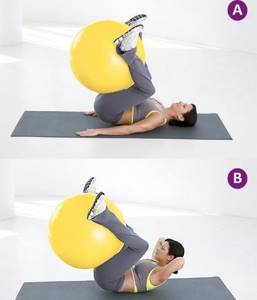
The reverse crunch is especially good for training the obliques. The starting position is lying down, legs are slightly bent, a ball is fixed between the legs, hands are fixed on the back of the head. You need to reach for the ball, controlling the position of your chin and not sticking your elbows forward. You should perform 12 repetitions in 3 sets.
Leg rotations while lying down
The basic idea behind prone leg twists is to use and maintain the lower extremities. This exercise works the oblique muscles, helping to create a slim waist. This exercise is performed lying down. Your arms should be extended to the sides to maintain balance, your legs should be closed and raised at a right angle.
As you exhale, you need to slowly lower your legs to the right, while inhaling, raise them again, and as you exhale, lower them to the left. The lower back should remain motionless and pressed to the floor. For a good effect, repeat these steps during training 2 sets of 10 times.
Bent-overs with dumbbells
When performing inclines with dumbbells, it is important to choose the correct weight of the weighting agent: for women, the maximum is 3 kg. This exercise allows you to improve your posture, reduce the level of fat on the lower back, and thanks to the additional weight, it is better to work out your sides.
Starting position: standing, feet shoulder-width apart. A dumbbell is taken in one hand, and the free hand is placed on the belt. Next, bend towards the arm with the dumbbell, fixate at the lowest point for a couple of seconds and return to the starting point.
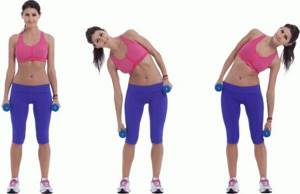
At the same time, when bending, the arm with the weight should move along the body, and the body should not be tilted forward or backward, otherwise the effectiveness of the movements will be minimal. Also, haste when performing bends with dumbbells is inappropriate, because with sudden movements there is a high risk of spinal injury. The exercise is performed 10 times in each direction for 3 approaches.
Bending the body in a lying position and twisting in the opposite direction
Crunches are rightfully considered the most effective exercises for working the lateral abdominal muscles. To perform twists in the opposite direction, you need to take a lying position, hold your hands behind your head, bend your legs and place them on the floor.
Next, you need to raise your body, trying not to lift your lower back from the floor and not bring your elbows forward. The elbow should be pulled towards the opposite knee to increase the load on the oblique muscles. You should perform 2 sets of 15 times on each side.
Bending the body in a lying position and twisting in the same direction
Twisting in the same direction is performed in a manner similar to the previous exercise. The only difference is that you need to reach with your right elbow towards your right knee, and with your left towards your left. In this case, the upper abdominal muscles are more involved. 15 repetitions are expected on each side in 2 sets.
Seated crunches
Seated crunches are performed on a mat. It is necessary to bend your legs, place your feet on the floor, and lean your body back. The lower back should be rounded, and the angle between the body and the floor should be approximately 45 degrees. It is necessary to twist from side to side. The number of repetitions of this exercise during training should be at least 10 on each side in 2-3 approaches.
Side crunches
Lateral or oblique twisting is a moderately difficult exercise in which the effect is achieved through the position of the legs. The exercise is performed lying on your side. In this case, your legs should be bent at the knees. The lower arm must be straightened and placed on the floor, and the upper arm must be removed behind the head.
Next, you should raise your body and return to the starting position. It is important when performing twisting not to strain your neck or press your head. It will be enough to slightly raise the body to a height of 2-3 cm. You should perform 2 sets of 20 times on the right and left sides.
Oblique Bridge
An oblique bridge or side plank is a static exercise. It is better to do it several repetitions (4-6 times) for as long as possible. The starting position for the side plank is the position lying on your side. In this case, one foot should be slightly forward and also rest on the floor.
The top hand can be placed on its side or extended upward to make it more difficult. Next, you need to place your lower hand on your elbow and carefully straighten it. The body should be a straight line, and all muscles should be tense.
Boat
“Boat” is an exercise known in Pilates. To perform it, you need to lie on the floor, straighten your legs, and place your arms along your body. Next, you need to simultaneously raise your straight legs, body, pull your arms towards your knees and stay in this position for the maximum amount of time. For the first workout, it is enough to do the “boat” once, increasing the number of repetitions with each session.
Crunches on a fitball
Twisting on a fitball is an isolating load aimed at working the abdominal muscles. You need to sit on the ball and lean back. Your feet should be on the floor at a 90-degree angle, your left arm bent behind your head, your right arm extended forward. Then you should raise your body and stretch your right hand towards your left knee. The exercise must be performed 10 times for each side, 3 sets.
Exercise "vacuum"
In the “vacuum” exercise, the main emphasis is on proper breathing. The vacuum helps reduce waist size, reduces lower back pain, and improves overall body tone thanks to a kind of massage of internal organs.
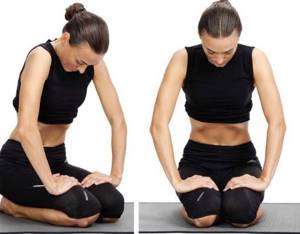
During the postoperative recovery period, during pregnancy, ulcers and during menstruation, you should refrain from performing this exercise. Before doing a vacuum for the abdomen, it is better not to eat or drink, so the recommended time for it is in the morning.
The easiest version of this exercise is in a lying position, and the most difficult is standing.
To perform a vacuum, you need to take the starting position, take a deep breath and exhale slowly, while simultaneously trying to draw in your stomach as much as possible. After this, you should hold your breath for at least 15 seconds and inhale slowly, relaxing your muscles. The time of holding your breath should gradually be increased to 60 seconds, and the number of repetitions to 5 times.
Hoop torsion
Thanks to the hoop twisting, the stomach is tightened and the sides are significantly reduced, because 10 minutes of such exercise is equivalent to running and burns about 100 calories. When practicing with a hoop, the more muscles will be involved, the narrower the legs are apart during torsion. You need to spin the hoop for the same amount of time in different directions.
During the exercise, the body should remain motionless, and all efforts should be placed on the abdominal muscles. The first lessons with a hoop can last about 5 minutes. Next, you should gradually increase the duration of the exercise. Fitness trainers say that to lose weight in your hips and waist, you need to spin a hula hoop for at least 15 minutes a day. In this case, it is advisable to do several approaches.
Exercise No. 2: full Set up with added twist
We sit completely on our sit bones and raise not only our shoulder blades, but also our shoulders. When lifting, the abdominal and back muscles work, and the hip flexor muscles are more involved. In a sitting position, we add a twist, which gives a little emphasis on the obliques. Exhale while lifting (effort), while doing so we draw in the stomach, directing the navel to the lower back, making a kind of vacuum. We sit completely on our sit bones and raise not only our shoulder blades, but also our shoulders. When lifting, the abdominal and back muscles work, and the hip flexor muscles are more involved. In a sitting position, we add a twist, which gives a little emphasis on the obliques. Exhale while lifting (effort), while doing so we draw in the stomach, directing the navel to the lower back, making a kind of vacuum.
Training plan
If you have decided to seriously take care of yourself, but have never visited such establishments before and do not know how to properly structure your work process and coordinate your work activities in the gym, contact the specialists. Today, almost every sports club provides, as one of the services of its complex, linking the client to the appropriate personnel - a qualified coach. The gym administrator will introduce you to a possible list of candidates for the role of your mentor for completing a course of physical exercises, and will also tell you which trainer is able to provide you with comprehensive assistance, taking into account the plan for creating a diet for each day. Such an option is, of course, ideally envisaged.
But conditions do not always work out for us the way we would like. Your local gym may not offer this type of service or may not have qualified staff. In addition, an individual trainer is not a cheap pleasure, and therefore many may not be able to bear such costs due to lack of financial opportunity. It is for such cases that an overview of the most effective options for working with sports equipment, which are aimed at losing weight at the waist, is provided. In the gym, exercises for women seeking to get rid of excess weight in the sides and abdomen involve the use of several types of equipment to achieve their goal. And in this case, it is advisable to draw up a plan for a training program.
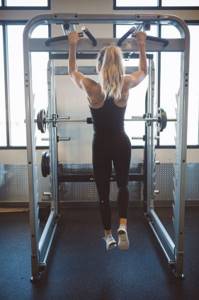
Exercise No. 3: bicycle, or diagonal crunches with shock absorber footwork
The position of the foot is toes towards you. Hands behind your head, elbows pointing to the sides, chest open, lower back pressed tightly to the floor. We raise our upper back, stretch our shoulders diagonally to the opposite knee, keeping our lower back tightly pressed. We inhale, and as we exhale we change sides. We straighten one leg as much as possible, and point the other towards us as much as possible. Shoulder diagonally to the opposite leg as you exhale. The position of the foot is toes towards you. Hands behind your head, elbows pointing to the sides, chest open, lower back pressed tightly to the floor. We raise our upper back, stretch our shoulders diagonally to the opposite knee, keeping our lower back tightly pressed. We inhale, and as we exhale we change sides. We straighten one leg as much as possible, and point the other towards us as much as possible. Shoulder diagonally to the opposite leg as you exhale.
Turns while lying down
An excellent method for working out the area of the lateral lines and abdominals are the same turns carried out by the torso by swinging the legs, but in a lying position. This exercise is not easy, but it is also quite effective. The point of doing it lies in a simple technique:
- The initial position is to lie with your back on the floor, keeping your shoulder blades in the same position throughout the entire exercise, your arms can be lowered along the body or placed to the sides to maintain balance and firmly fix the shoulder blades on the floor.
- At the count of “one,” the legs lift off the floor, the pelvis turns slightly to the right side and, together with the legs moving in the same direction as the pelvis, they strive to go as far to the right as possible.
- On the count of “two,” the pelvis rapidly turns in the opposite direction, and the legs, accordingly, follow it and try as much as possible to go to the left.
Three sets of 10-12 repetitions on each side will make you feel a sweet pain, indicating the effectiveness of the work done. You can use the second method of rotating the pelvis while lying down: bend your knees. This way, performing the exercise will become much easier, since the amplitude of movement of the legs will not be so wide.
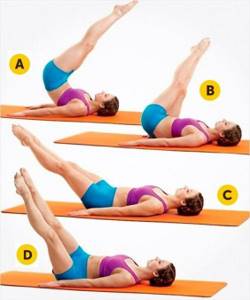
Exercise No. 4: Russian twist
Starting position - sitting on the buttocks, feet hip-width apart, resting on the heels, toes pointing towards you. The position of the back is maximum vertical extension, the top of the head is directed upward, the lower back is extended. Weight at chest level. Hands in the center of the chest. We rotate the spine around its axis, keeping the transverse abdominal muscle tense, directing the navel to the lower back, the back is straight. Each turn we exhale, with weights we stretch in the opposite direction. Starting position - sitting on the buttocks, feet hip-width apart, resting on the heels, toes pointing towards you. The position of the back is maximum vertical extension, the top of the head is directed upward, the lower back is extended. Weight at chest level. Hands in the center of the chest. We rotate the spine around its axis, keeping the transverse abdominal muscle tense, directing the navel to the lower back, the back is straight. Each turn we exhale, with weights we stretch in the opposite direction.
Jumping rope
The top of the best exercises for reducing the volume of the abdomen and sides opens with general exercises - those that are multidirectional, but directly affect the reduction of the waist. An exercise in the form of jumping rope is one of these.
The jump rope is the worst enemy of fat deposits, which are deeply embedded in the most problematic areas of the human body. Therefore, for those girls who want to make their waist thinner, this exercise will become the number one assistant. Since jumping rope is considered a fairly energy-intensive activity, the level of fat burning here is quite high. Of course, in order to really lose weight, reduce your body weight and, accordingly, make your waist thinner, you need regularity and a certain duration of performing this exercise.
Three classes a week for 10 minutes will not finish the job and will not be successful. It is necessary to jump rope cyclically, the rhythm of the jumps is changed in the cycle, and the speed of their execution is constantly adjusted and regulated. For example, continue 30 seconds of intense jumping with 15 seconds of moderate jumping and finish the circle with 40-50 movements as fast as possible. And such circles should be performed from 5 to 10 with breaks of a minute or two.
You can complicate the exercise and increase its efficiency using turning movements at the waist while jumping. One jump - the legs turn in one direction, the other jump - in the other. The effect will not take long to appear.
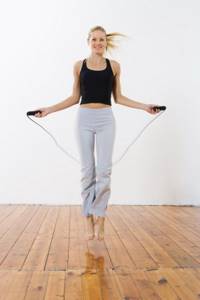
Warm-up
Exercise 1. Preparing the muscles of the thighs and sides for the main load
Starting or first position. The person must stand on the floor. His legs should be spread shoulder-width apart, and his hands should rest with his palms on his waist. Do bends alternately in different directions, without removing the palms of your hands from your waist.
For beginners, the optimal number of repetitions in this exercise is from 4 to 9 times per approach to bending.
For experienced people who have an understanding of physical activity, the number of repetitions in the exercise is from 10 to 16 times in a bending approach.
Exercise 2. Preparing the side muscles to take on the main load
Starting position: stand on the floor. Your feet should be shoulder-width apart and your hands should rest with your palms on your waist. Lean forward and then lean back, trying not to change the position of your hands.
Before starting a workout, you should stretch your muscles well to increase the effectiveness of the exercises and reduce the likelihood of injury during exercise.
For beginners, the optimal number of repetitions of the exercise in a set is from 5 to 8 times. For experienced people familiar with physical activity, the optimal number of repetitions in the exercise is from 10 to 16 times per approach.
You should move smoothly to avoid unnecessary traumatic stretching.
Exercise 3. Preparing for the main load - warming up the muscles of the thighs, legs and sides
Starting position: stand straight, eyes looking forward. You should run in place.
For beginners, the duration of running in the exercise is from 30 to 60 seconds. For people who have an understanding of physical activity, the duration of running in the exercise ranges from 1 minute to 3 minutes.
When performing this exercise, you should raise your feet high to properly stretch the muscles of your legs.

